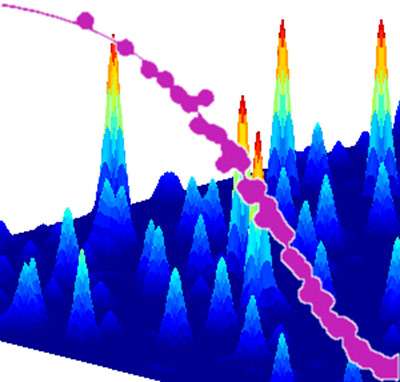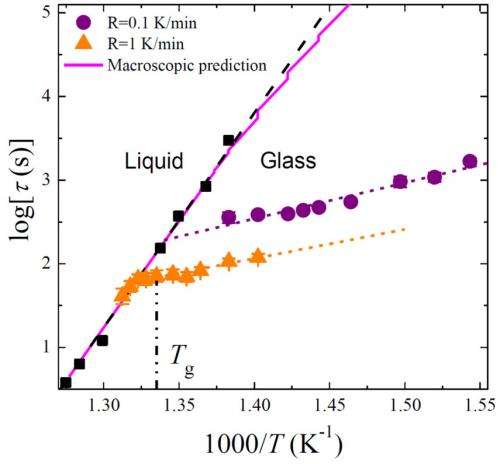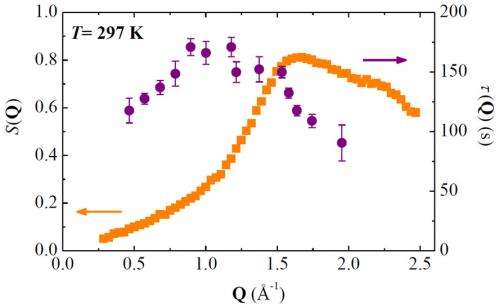Revealing the fast atomic motion of network glasses with coherent X-rays

The remarkable properties of glasses are due to their dynamical arrested state in which relaxations occur on time scales too large to be observed, or so it was believed. Now researchers have discovered the existence of unexpected fast atomic rearrangements occurring within a few minutes for the atomic motion of a silicate glass, even while it was in the deep glassy state. These results modify our conception of the glassy state and call for a new microscopic theory.
Glasses are essential materials in present day science and technology. The optimisation of materials properties for technological applications is often the result of a trial-and-error approach, as a basic understanding of many of their properties is still lacking. In particular, the intrinsic non-equilibrium nature of glasses poses formidable problems both for experiments and theory. Therefore, while important progress has been made in the understanding of the dynamics of their high temperature phases, the so called glass-forming liquid phase, a microscopic theory of glasses is still missing due to the extreme difficulty of probing the structural relaxation of a glass far below the glass transition temperature Tg, either with experiments or simulations [1].
Thanks to improved instrumentation for the collection of sparse scattering signals [2] and to an increased flux and coherence of X-ray beams at beamline ID10, X-ray photon correlation spectroscopy (XPCS) has become a very powerful technique able to follow the evolution of the dynamics at the atomic length scale in crystalline and amorphous materials [3].
An international research team used XPCS at beamline ID10 to follow the temporal and temperature evolution of the relaxation dynamics in a prototypical network glass, a sodium silicate, at both the mesoscopic and atomic length scales for the first time. The experiments showed the existence of fast collective atomic motion in the glassy state; this is in contradiction with the common idea of an ultraslow arrested out-of-equilibrium state: upon cooling the system from the melt to the glassy state, the structural relaxation time strongly departs from the supercooled liquid behaviour and displays a weak temperature dependence characterised by relaxation times of 50-1000 s even in the deep glassy state (Figure 1 and Figure 2). This fast atomic motion is accompanied by the absence of any detectable physical aging not even in the glass transition region, in disagreement with macroscopic studies and theoretical approaches (Figure 1) [1]. Indeed current phenomenological models for relaxation in glasses, like the TNM model [1], assume that the physical aging takes place on a time scale comparable to the structural relaxation time, and this is usually the case for macroscopic observables. Differently from macroscopic studies, the microscopic dynamics now unveiled remains stationary in the glassy state, even in those cases when the annealing time is much longer than the structural relaxation time expected from a simple extrapolation of the supercooled liquid relaxation times. These results indicate a different physical mechanism responsible for the relaxation dynamics at the microscopic level, something that is novel and not predicted by previous experimental and theoretical work.

Some insight in this novel dynamics can be gained by looking in detail at its dependence on the scattering vector: the relaxation time shows two different peaks, one close to the position of the maximum of the static structure factor, and a second maximum at the mesoscopic scale, in correspondence to a well-characterised structural peak, known as the prepeak. While the first one is reminiscent of the de Gennes-like narrowing also observed in coherent neutron scattering experiments of supercooled liquids, the second one is in correspondence to the characteristic distance between the sodium diffusion channels in the network, in agreement with high temperature simulation in molten silicates [4].

Overall this observed complex microscopic dynamics calls for a reexamination of phenomenological models and a need for a new microscopic theory for network glasses.
More information: B. Ruta (a), G. Baldi (b), Y. Chushkin (a), B. Rufflé (c), L. Cristofolini (d), A. Fontana (e), M. Zanatta (f) and F. Nazzani (g), Revealing the fast atomic motion of network glasses, Nat. Commun. 5, 3939 (2014). dx.doi.org/10.1038/ncomms4939
[1] L. Berthier and G. Biroli, Rev. Mod. Phys. 83, 587-645 (2011).
[2] Y. Chushkin, C. Caronna and A. Madsen, J. Appl. Cryst. 45, 807-813 (2012).
[3] M. Leitner et al., Nat. Mat. 8, 717 (2009). B. Ruta et al. Phys. Rev. Lett. 109, 165701 (2012).
[4] J. Horbach, W. Kob and K. Binder, Phys. Rev. Lett. 88, 125502 (2002). A. Meyer et al., Phys. Rev. Lett. 93, 027801 (2004).
Provided by European Synchrotron Radiation Facility












.jpg)







